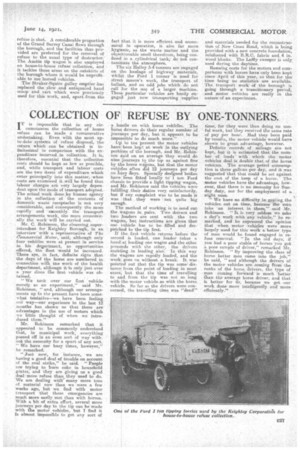THE MOTORS OF A SMALL MUNICIPALITY.
Page 26

Page 27

If you've noticed an error in this article please click here to report it so we can fix it.
Eleven Motor Vehicles Employed by One of the Smallest Metropolitan Boroughs.
ALL THE LONDON boroughs use motor vehicles for municipal transport work and, without a datibt, the various types of machines which are employed are directly responsible for saving ,:he ratepayers many hundreds of pounds annually by performing the diversified duties of local authorities both efficiently and economically. As all the Metropolitan lieroughs are huddled into a comparatively small area, one might almost be justified in drawing a conclusion that municipal work in each of thoip. is of a similar natures. and that the conditions of operation in neighbouring boroughs are almost identical. Such, however, is not the case, and many important and often peculiar local factors have a direct influence on municipal work.
As a matter of fact., two boroughs butting on to one another are quite likely to offer a dissimilar set of conditions which are often responsible for what. may appear to be misleading cost figures.
As a case in point, take two boroughs undertaking road repairs in their respective areas, one pf which has a canal frontage, whilst the authorities in tha other are solely dependent upon railway facilities. The former body would be in a position to have their raw materials and_ supplies water-borne right to the storing depot, whilst the latter would be called upon to pay inflated railway rates plus cartage charges from the railway torinfnits to the depot. This, disparity in transport charges would adversely influence the cost of the road repair work, and to those unfamiliar with the different circumstances the comparative costs for identical work would seemingly be due to a discrepancy in calculations.
The number of motor vehicles in the service of each of the different boroughs varies according to its size, and this is one of the reasons that the Deptford Borough Council is a small user. The Borough of Deptford has an area of 1,563 acres (about 2 square miles") and some 53 miles of streets, and motors playtheir part in connection with the repair,
upkeep, and maintenance of the latter, whilst they also perform other work under the jurisdiction of the highways department, which-employs a total of 11 machines.
The first motor vehicle of the present fleet was purchased in 1918, and it has been the object of Mr. H. Morley
Lawson, M.Inst. C.E A.M.Inst . T. ,
to standardize one type of machine for a particular class of work. The fleet is composed of six 3-4 ten Halley tipping wagons, a 3-4 ton Halley lorry (the body. of which is interchange-. able with a road sprinkler body of 750 gallon capacity), a Straker-Squire gulley emptier of 750 gallon capacity, a 1 ton Ford tipping wagon, a 3 ton Austin tipping lorry, and a Laffiy sweeper. In addition to the motor vehicles 32 horses are employed. The motor vehicle fleet has been responsible for t-he entire elimination of the need for hiring horses, which method is both costly and inefficient, and sooner or later the council's own stud may be supplanted by motors. The horsedvehicles are employed on house-to-house refuse collection in districts which are in close proximity to the barges into which the
refuse is shot. A considerable proportion of the Grand Surrey Canal flows through the borough, and the facilities thus provided are preferred for the removal of refuse to the usual type of destructor.' The Austin tip wagon is also employed on house-to-house refuse collection, and it tackles those areas on the outskirts of the boxough where it would be unprofitable to use horsed vehicles.
The Straker-Squire galley emptier -has replaced the slow and antiquated hand scoop and cart which were previously used for this work, and, apart from the fact that, it is more efficient and economical in operation, is also far more hygienic, as the waste matter and the objectionable smell therefrom, being confined in a cylindrical tank; do not contaminate the atmosphere.
The six Halley 3-4 tonners are engaged on the haulage of highwaymaterials, whilst the Ford I tonner is used for street mason's work, the transport of ballast, and on odd jobs which do not call for the less of a larger machine. These particular vehicles are busily engaged just now transporting supplies
and materials needed for the reconstruction of New Cross Road, which is being provided with a new concrete foundation, reinforced with B.R.O. fabric and. 4 in. wood blocks. The Laftly sweeper is only used during the daytime.
Running costs for the motors and comparisons with horses have only been kept since April of this year, so that for the time liei.ng no statistics are available. The transport, work of the borough is going through a transitionary period, and motor vehicles are really in the
nature of an experiment. '






































